Ever stared at your phone, TV, or laptop and wondered what makes the screen tick? Display technologies power everything from blockbuster movies to late-night scrolling. Some screens lean on backlight technology to shine, while others glow all on their own.
Today, we are diving deep into the world of LCD screens, LED displays, and OLED displays comparing how they work, what they need to light up, and why it matters to you. Ready to see the tech behind your favorite visuals? Let’s roll!
Which Display Technologies Require Backlighting? Comparing LCD, LED, and OLED
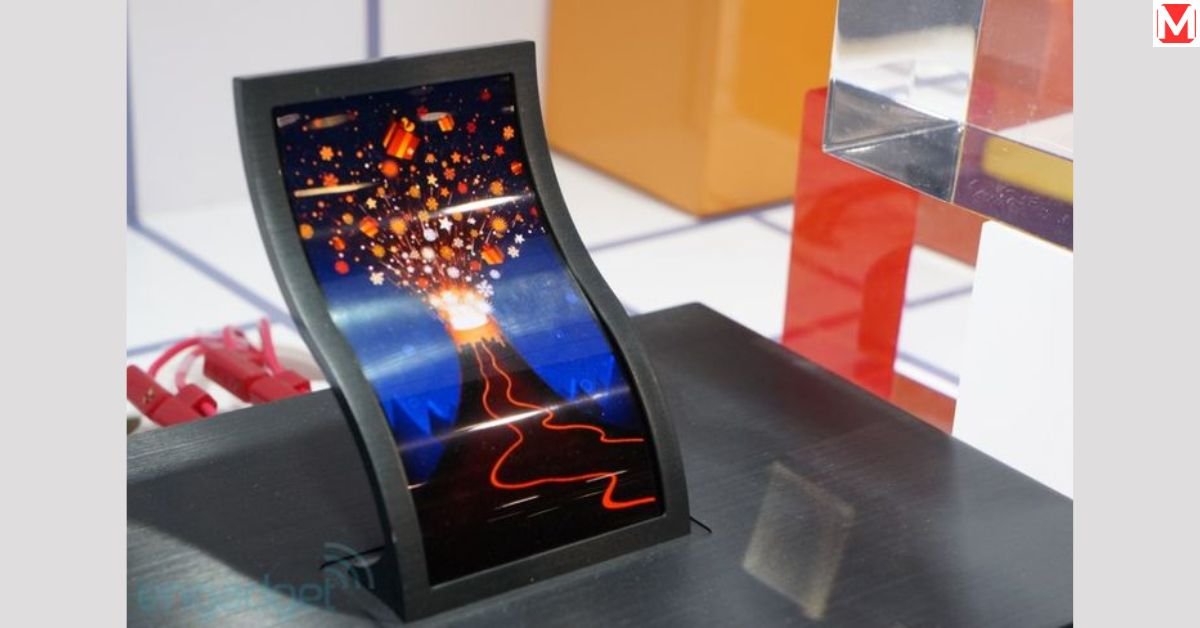
You are binge-watching a show, and the screen lights up your room. But not all screen technology works the same way. Some displays like LCD screens and LED displays rely on a brightness system called backlighting to make images pop. Others, like the slick OLED display, skip the middleman with self-emissive magic. So, what’s the deal?
At their core, display panels fall into two camps: those needing a lighting layer and those that don’t. LCD screens twist liquid crystals to shape light, but they can’t glow solo enter backlight technology. LED displays, despite the fancy name, are just LCD panels with a modern twist: they swap old-school CCFL backlights for efficient LEDs. Meanwhile, OLED displays stand out with emissive pixels that light up independently. No screen illumination required.
Why should you care? Think about your devices. Your budget-friendly smartwatch might rock an LCD monitor, while your premium TV flaunts an OLED panel. Each choice balances cost, quality, and tech. For example, a $50 LCD powers a basic tablet, but a $1,000 OLED TV delivers cinema-grade visuals. Let’s break it down further.
Quick Comparison Table
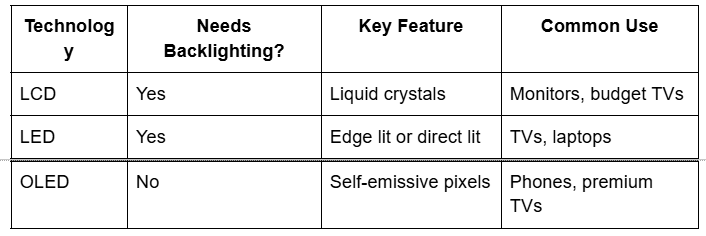
LCD Displays: Relying on Backlights for Over Two Decades

LCD screens have been a staple since the ‘90s. From clunky CRT replacements to sleek flat panel displays, they’ve stuck around for a reason. But here’s the catch: liquid crystals don’t glow. They need backlight technology to shine.
How does it work? Inside an LCD panel, crystal molecules twist and turn to control light. Sandwiched between polarizing filters, they act like tiny shutters letting light through or blocking it. Behind them sits a panel light source, originally CCFL backlights (cold cathode fluorescent lamps). These cold cathode lights were bulky tubes, pumping out 200-300 nits of brightness—decent for the early 2000s.
Take an old Dell monitor from 2005. Its CCFL tubes hummed along, delivering 720p visuals for office work. Fast forward to today, and LCD monitors often use LED backlights instead. Why the switch? LEDs sip less power 70 watts versus 120 watts for CCFL and last longer, up to 50,000 hours. Still, LCD screens dominate budget markets. A 24-inch panel costs $50-$100 to produce, making it a go-to for schools and offices.
But there’s a trade-off. Those screen layers filters, crystals, and backlights make blacks look grayish. Ever notice how dark scenes on an old TV feel flat? That’s the light modulation struggling. Plus, modern screen innovations like slim laptops leave chunky LCD designs in the dust.
LCD Pros and Cons
- Pros: Cheap to make, lasts decades, widely available.
- Cons: Washed-out blacks, thicker builds, slower refresh rates (60Hz vs. 120Hz on newer tech).
Fun fact: By 2023, LCD still held 60% of the global TV market, per Statista. Affordability keeps it kicking!
LED Display Technologies: Bright Pixels But Still Requiring Backlights

Don’t let the name fool you LED displays aren’t a radical leap from LCD screens. They’re LCD panels with a glow-up, swapping CCFL backlights for light emitting diodes. The result? Brighter, more efficient screen illumination. But they still need that backlight technology crutch.
Mini-LEDs take it up a notch. These tiny diodes sometimes 2,000 in a single TV offer pinpoint direct backlight control. Hisense’s U8K, launched in 2023, boasts 1,000+ dimming zones. That’s a leap from the 50 zones in older direct lit LED models. Brightness soars, and contrast sharpens almost rivaling OLED monitors.
LED panels can’t ditch backlights. Those edge backlight or rear lighting systems mean light bleeds a bit. Watch a starry sky on an LED screen, and you might spot a faint halo around bright spots. Compare that to self-lit pixels, and LED falls short on true black.
Case Study: LED in Action
LG’s 55-inch C3 Evo LED TV, released in 2023, rocks a mini-LED backplane. Testers at RTINGS.com clocked it at 650 nits bright enough for sunny rooms. Side-by-side with an OLED panel, though, its blacks looked more charcoal than pitch. The brightness system shines, but depth takes a hit.
LED Variants at a Glance
- Edge Lit: Slim, affordable, 300-500 nits.
- Direct Lit: Better contrast, 500-700 nits, thicker build.
- Mini-LED: Precision lighting, 700-1,000 nits, premium price.
“LEDs bring the brightness, but backlights limit their soul.” – Tech reviewer, 2025.
Display Technologies OLED Stands Apart With Self Emissive Pixels and No Backlights
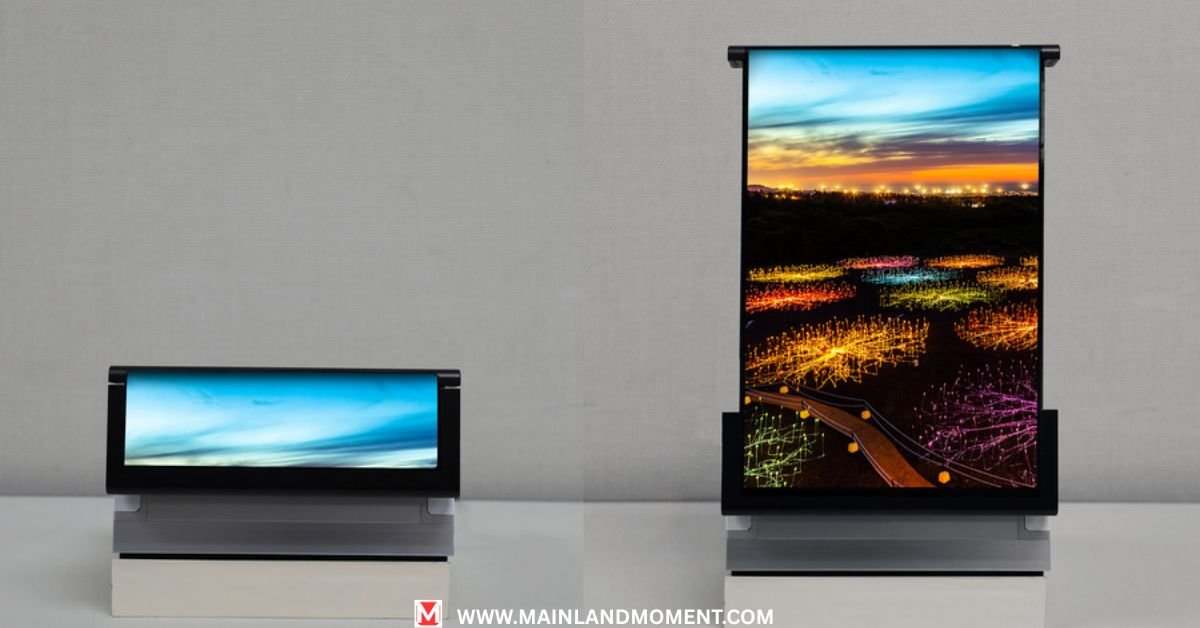
Enter the rockstar of visual display: OLED displays. Unlike LCD screens or LED panels, these bad boys don’t mess with backlight technology. Each pixel is self-emissive, meaning it generates its own light. The result? A screen technology that’s as close to real life as it gets.
How does it work? Organic compounds in an OLED panel light up when juiced with electricity. No lighting layer, no polarized layer just pure independent lighting. Turn a pixel off, and it’s blacker than a moonless night. Crank it up, and colors explode LG’s G4 OLED TV hits 1,000 nits peak. That’s why OLED monitors rule premium markets, from the iPhone 15 Pro ($999) to Sony’s A95L ($2,800 for 65 inches).
The perks are unreal. Flexible screens? Check Samsung’s Galaxy Z Fold 6 bends thanks to OLED’s freedom from rigid edge backlights. Perfect blacks? Absolutely each emissive pixel shuts off completely. Watching The Matrix on an OLED monitor, those neon greens and inky blacks pop like nothing else. Colors cover 120% of the sRGB gamut, blowing past LED’s 90%.
But there’s a hitch. Burn-in risks lurk leave a news ticker on for 1,000 hours, and faint ghosts might linger. Cost stings too. A 55-inch OLED display runs $1,200 versus $400 for a solid LED screen. Lifespan lags as well 30,000-50,000 hours compared to LED’s 50,000-100,000.
OLED By the Numbers
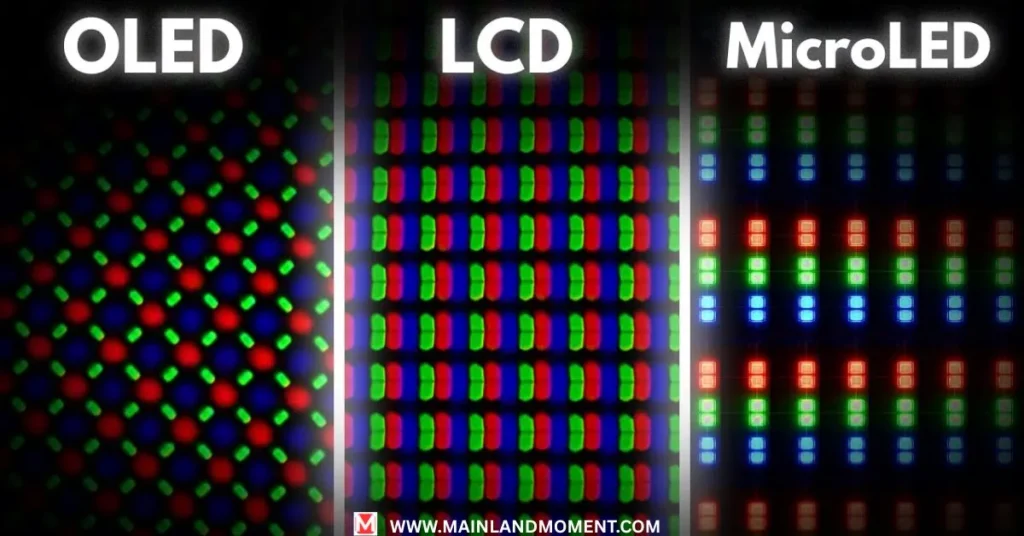
- Lifespan: 30,000-50,000 hours.
- Brightness: Up to 1,000 nits peak.
- Cost: $20-$30 per square inch vs. $5-$10 for LCD/LED.
Real-World Example
Sony’s A95L QD-OLED, launched in 2024, pairs organic LED with quantum dots. Result? 1,200 nits and perfect blacks. Gamers rave about its 0.1ms response time no display material matches that speed.
Frequently Asked Question
Which is cheapest long-term—LCD, LED, or OLED?
LCD screens win upfront—$100 for a 32-inch TV beats $400 for an LED display or $1,200 for an OLED panel. Over time, LED screens save more. A 55-inch LED at 60 watts versus LCD’s 100 watts cuts $15 yearly (13 cents/kWh). OLED displays dazzle but cost more to replace sooner.
Can LED ever ditch the backlight?
LED panels are LCD screens at heart liquid crystals need a light source. Even mini-LEDs refine back panel lighting, not eliminate it. Self-emissive tech is OLED’s turf.
Why does OLED feel so premium?
It’s the self-emissive display magic. Each glow pixel delivers perfect blacks and vivid colors—1,000 nits and 100% DCI-P3 coverage. Your $1,000 phone screen proves it—no side illumination can compete.
Are backlights bad for your eyes?
Not inherently. Screen optics like blue light matter more. Harvard Health notes blue light disrupts sleep—CCFL backlights and LEDs emit it, but OLED’s pixel illumination cuts it slightly. Filters help across all monitor types.
What’s the brightest tech?
Mini-LED and OLED tie at 1,000-1,200 nits. Direct lit LED hits 700, while LCD screens with old LCD backlight lag at 300-500.
Conclusion
So, backlights or bust which display technology wins for you? LCD screens and LED displays cling to backlight technology, keeping costs low and brightness high. OLED displays break free with self-lit pixels, delivering jaw-dropping visuals at a premium. Your $200 LED TV suits casual viewing, but a $1,500 OLED transforms movie night into art.
Each shines in its lane. LCD panels power classrooms on a dime. LED screens light up living rooms with punchy edge lit or direct lit flair. OLED panels steal the show for gamers and cinephiles, flexing screen innovations like foldables. Next time you binge-watch, thank the tech lighting your screen or not.
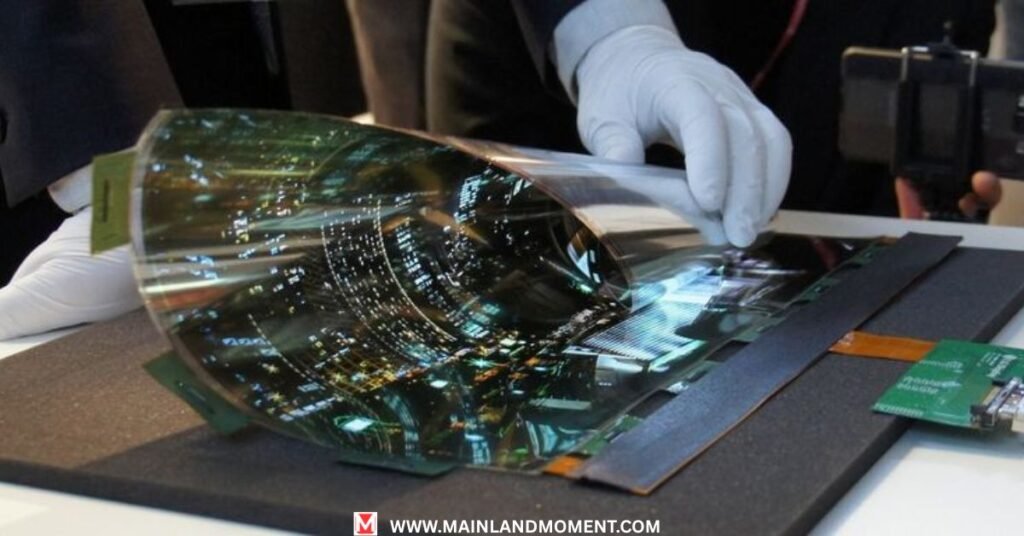


Pingback: Qualified Battery Storage Technology: Powering America’s Clean Energy Revolution
Pingback: Decoding The Future: A Deep Dive Into Encoding Technology
Pingback: Fiber Optic Technology: Revolutionizing Communication Across The United States
Pingback: How To Cancel ProBiller Membership: Your Complete 2025 Guide